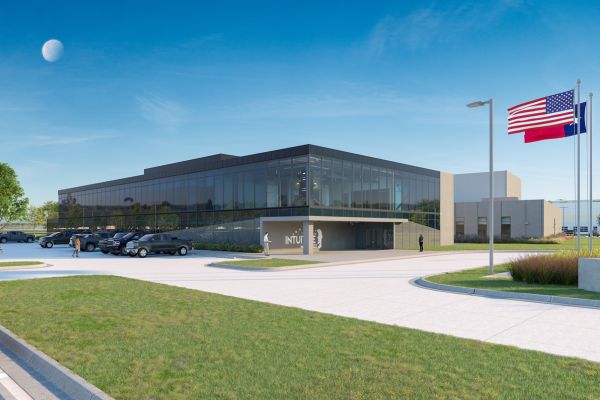Houston Spaceport Reaches for the Stars with Transformative Expansion Project
Published Feb 23, 2024 by Hailea Schultz
With three new cutting-edge anchor tenant facilities and its second phase of development underway, the Houston Spaceport has undergone a full transformation since the city first vowed to reshape Ellington Airport into an aerospace hub in 2015.
In 2018, the Houston City Council approved nearly $20 million in funding for infrastructure development at the Spaceport, marking the beginning of a major multi-phase expansion project. Here’s a look at the spaceport’s transformative journey and where we are today.
Phase I
The first phase of Houston Spaceport’s expansion, completed in 2019, included construction of streets, utilities and distribution and communications facilities.
The Houston Airport System later appropriated up to $105.6 million to finance construction for three leading aerospace companies, including Intuitive Machines. The three-time NASA Contract winner recently made history with its Nova-C lander Odysseus becoming the first U.S. spacecraft to land on the moon since the Apollo.
Intuitive Machines opened its $40 million Lunar Operations Center at the Houston Spaceport last year. Spanning 12.5 acres, the new center includes 125,000 square feet of office and production space that will be dedicated to the company’s lunar program and the manufacturing of lunar landers and spacecraft.
The center also offers unique technologies and infrastructure including “mission control rooms to track and manage lunar missions, a propulsion test facility to assess lunar lander engine capabilities and a 3,800 square foot ‘flame range’ facility for testing protocols,” according to Intuitive Machines.
“Houston has always been a city that reaches for the stars, and with Intuitive Machines operating at the Houston Spaceport, our city is poised to shine even brighter in the cosmos,” said Mayor Sylvester Turner. “Aerospace is more than a source of pride for our city; the innovation here is just another example of why the Houston economy is thriving. Intuitive Machines is fueling high-paying jobs, fostering innovation, and attracting talent and investment from every corner of the world.”
Intuitive Machines was recently awarded $2.4 million from NASA to collaborate with Washington, D.C.-based Zeno Power to create a Radioisotope Power System for astronauts travelling to the moon during its lunar night cycle.
In 2022, commercial space leader, Axiom Space, broke ground on its 22-acre Space Flight and Assembly headquarters at the spaceport. The new headquarters will be dedicated to the development of the Axiom Station, dubbed as the world’s first commercial space station.
The groundbreaking campus will also support astronaut training and feature mission control facilities, testing labs, and a high bay production facility, according to Axiom Space.
A ribbon-cutting ceremony was held in December 2023 to officially open the first phase of the development.
Axiom Space has also been awarded several NASA contracts, including a spacesuit task order to advance the Artemis III lunar spacesuit design for International Space Station (ISS) spacewalking capabilities in low Earth orbit.
The new facility focuses on the development and testing of the company’s NASA task order next-generation spacesuit for astronauts to wear while working outside the ISS and on the moon, as well as Collins’ Universal Waste Management System and trash compactor, according to the company.
Additionally, 10,000 square feet of the new facility is dedicated to Houston’s first-ever spaceflight incubator, which enables startups, industry professionals and universities to collaborate to advance aerospace technology and exploration.
The three anchor companies are expected to bring as many as 1,800 jobs to the area in addition to $4 billion worth of contracted work over the next decade, according to Houston Spaceport Director Arturo Machuca.
Phase I of the spaceport also included the opening of San Jacinto College’s EDGE Center in 2021, a 154-acre development offering aerospace training and programs that will drive promising pathways to careers in the industry.
"This is where the next chapter of the rivalry to space will be written by the minds and hands of Houstonians for generations to come,” said Houston Airport System Director Mario Diaz in a press release. “The talent who will learn how to build toward the future of space exploration starts right here at the EDGE Center."
Phase II
Expected to break ground in the next 12 to 18 months, the second phase will span 300 acres and include major additions to its infrastructure including a full-length taxiway along Runway 4-22, northwest of the spaceport, according to Community Impact. The new taxiway will allow aircraft to take off and land right next to the spaceport’s anchor companies.
Other infrastructure projects include the construction of a road that runs through the middle of the spaceport, diverting traffic from Space Center Boulevard through the spaceport and connect to Highway 3 and space for hotel, restaurant and retail development.
According to Community Impact, Phase II includes the establishment of the Aerospace Institute, an extension of the EDGE Center, to connect higher education institutions and its students to the aerospace industry.
The Aerospace Institute will involve local colleges, including Texas Southern University (TSU), who recently announced a new two-acre training facility at the spaceport, and further bolster the region’s future workforce by helping students develop crucial skills needed in the industry.
Once complete, TSU plans to migrate their Aviation Management programs to this institute to help seamlessly translate their graduates into the Aerospace Industry workforce.
Discover more about Houston’s aerospace industry and the Houston Spaceport during the Partnership’s Future of Space event on Thursday, Nov. 7.
 The Houston Report
The Houston Report























